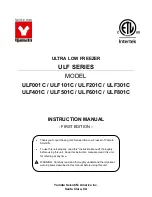
Tissue damage from cell death interrupts circulation in the
smallest blood vessels. Blood clots form and blood flow is
further diverted away from the frozen tissue. At this point,
your skin temperature drops and the injured area grow even
colder.
The first sign of frostbite may be a slightly painful tingling
sensation, which often is followed by numbness. Your skin
may look pale, and feel hard, cold and numb.
In the event of frostbite, warming is vital. Carefully warm
frost bitten areas gradually. Place your hands directly on the
skin of warmer areas of your body. If possible, immerse
your hands in water that is slightly above normal body
temperature (about 100
F or 37.8
C), or which feels warm to
someone else, until your normal color returns. Do not use
direct heat. Seek medical attention as quickly as you can.
7 REFRIGERATION COMPARTMENT
The refrigeration system of a Scientemp freezer is
hermetically sealed. It requires no maintenance. However, in
areas where excessive dust and dirt collects, the condenser
must be kept clean. To clean the condenser, remove power to
freezer. Remove the guard on the back of the freezer. Use
forced air and a vacuum to clean dirt and debris from the
condenser and refrigeration compartment periodically.
7.1 Fan
The fan motor has lifetime lubrication. It requires no
maintenance.
7.2 Frost removal
1.
While the freezer is running the frost may be
removed with a plastic or wooden scraper or
spatula. Do not use metal or sharp objects such as
an ice pick, as this will cause serious damage to the
finish of the inner-liner of the freezer. The frost and
ice may be collected in a pan, towel or any device to
prevent it from falling to the bottom of the freezer
or onto the material stored in the freezer. Most of
the frost and ice collects near the top edge and is
easily removed.
2.
In the case where the freezer is not loaded, frost and
ice may be removed by disconnecting the power
until the frost and ice thaw. After defrosting, dry
the freezer compartment interior and plug freezer
back in.
8 ALARM SIGNAL SYSTEM
SCIENTEMP Alarm signal system is a dependable, compact
unit designed to audibly alert you for temperature rise and
power failure. The Alarm is an audible and visual signal-
warning system. It produces a penetrating, repeating sound
to alert you.
The Alarm system, used in conjunction with a SCIENTEMP
low temperature cabinet, will monitor “temperature-rise” and
“power-failure”.
1.
Temperature rise and power failure is indicated by
flashing red light accompanied by a repeating
audible signal in the form of beep-beep-beep.
The Alarm system is powered by two (2) “9 volt” batteries.
It is important that the batteries be placed correctly in the
holders for the proper polarity. We recommend batteries be
replaced once a year to assure performance of the alarm.
Press the
“test button”
for frequent checks on battery life
and performance. If the Alarm fails to operate properly, it
may be due to a weak battery, which should be checked first.
8.1 Testing the Alarm Signal System
Switch the Alarm to the
“ON
” position. To simulate
“temperature-failure”, lower the set point temperature on the
controller to trigger the alarm. Once in operation, pressing
the
“TEST”
button checks for battery life.
*CAUTION: Wear protective clothing while either
handling or coming in contact with inside of freezer.
Hands should be dry and protected by using gloves.
Insulated gloves are best for extended use when
handling frozen product. Sleeves or arm-length
insulated gloves should protect arms. Coats,
insulated aprons, etc. should protect other parts of
the body that may be exposed to the cold.
Summary of Contents for 43-1.7A
Page 9: ......
Page 10: ...17B 3 1 14 4 5 6 10 9 14 15 17A 18 13 7 19 13 8 9 16 2 12 ...





























